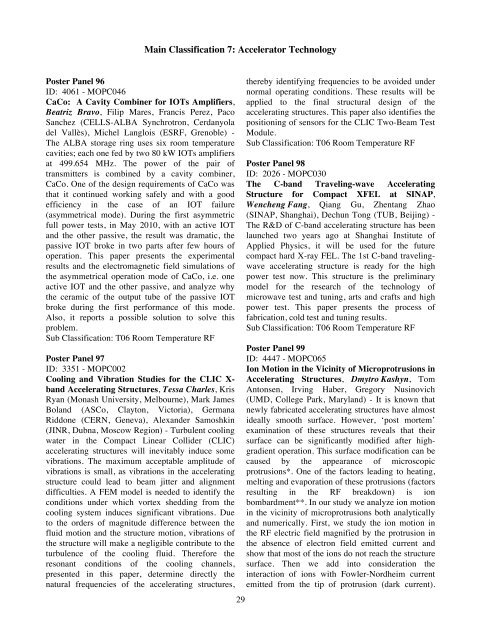Abstracts Brochure - 2nd International Particle Accelerator Conference
Abstracts Brochure - 2nd International Particle Accelerator Conference
Abstracts Brochure - 2nd International Particle Accelerator Conference
You also want an ePaper? Increase the reach of your titles
YUMPU automatically turns print PDFs into web optimized ePapers that Google loves.
Poster Panel 96<br />
ID: 4061 - MOPC046<br />
CaCo: A Cavity Combiner for IOTs Amplifiers,<br />
Beatriz Bravo, Filip Mares, Francis Perez, Paco<br />
Sanchez (CELLS-ALBA Synchrotron, Cerdanyola<br />
del Vallès), Michel Langlois (ESRF, Grenoble) -<br />
The ALBA storage ring uses six room temperature<br />
cavities; each one fed by two 80 kW IOTs amplifiers<br />
at 499.654 MHz. The power of the pair of<br />
transmitters is combined by a cavity combiner,<br />
CaCo. One of the design requirements of CaCo was<br />
that it continued working safely and with a good<br />
efficiency in the case of an IOT failure<br />
(asymmetrical mode). During the first asymmetric<br />
full power tests, in May 2010, with an active IOT<br />
and the other passive, the result was dramatic, the<br />
passive IOT broke in two parts after few hours of<br />
operation. This paper presents the experimental<br />
results and the electromagnetic field simulations of<br />
the asymmetrical operation mode of CaCo, i.e. one<br />
active IOT and the other passive, and analyze why<br />
the ceramic of the output tube of the passive IOT<br />
broke during the first performance of this mode.<br />
Also, it reports a possible solution to solve this<br />
problem.<br />
Sub Classification: T06 Room Temperature RF<br />
Poster Panel 97<br />
ID: 3351 - MOPC002<br />
Cooling and Vibration Studies for the CLIC Xband<br />
Accelerating Structures, Tessa Charles, Kris<br />
Ryan (Monash University, Melbourne), Mark James<br />
Boland (ASCo, Clayton, Victoria), Germana<br />
Riddone (CERN, Geneva), Alexander Samoshkin<br />
(JINR, Dubna, Moscow Region) - Turbulent cooling<br />
water in the Compact Linear Collider (CLIC)<br />
accelerating structures will inevitably induce some<br />
vibrations. The maximum acceptable amplitude of<br />
vibrations is small, as vibrations in the accelerating<br />
structure could lead to beam jitter and alignment<br />
difficulties. A FEM model is needed to identify the<br />
conditions under which vortex shedding from the<br />
cooling system induces significant vibrations. Due<br />
to the orders of magnitude difference between the<br />
fluid motion and the structure motion, vibrations of<br />
the structure will make a negligible contribute to the<br />
turbulence of the cooling fluid. Therefore the<br />
resonant conditions of the cooling channels,<br />
presented in this paper, determine directly the<br />
natural frequencies of the accelerating structures,<br />
�<br />
Main Classification 7: <strong>Accelerator</strong> Technology<br />
29<br />
thereby identifying frequencies to be avoided under<br />
normal operating conditions. These results will be<br />
applied to the final structural design of the<br />
accelerating structures. This paper also identifies the<br />
positioning of sensors for the CLIC Two-Beam Test<br />
Module.<br />
Sub Classification: T06 Room Temperature RF<br />
Poster Panel 98<br />
ID: 2026 - MOPC030<br />
The C-band Traveling-wave Accelerating<br />
Structure for Compact XFEL at SINAP,<br />
Wencheng Fang, Qiang Gu, Zhentang Zhao<br />
(SINAP, Shanghai), Dechun Tong (TUB, Beijing) -<br />
The R&D of C-band accelerating structure has been<br />
launched two years ago at Shanghai Institute of<br />
Applied Physics, it will be used for the future<br />
compact hard X-ray FEL. The 1st C-band travelingwave<br />
accelerating structure is ready for the high<br />
power test now. This structure is the preliminary<br />
model for the research of the technology of<br />
microwave test and tuning, arts and crafts and high<br />
power test. This paper presents the process of<br />
fabrication, cold test and tuning results.<br />
Sub Classification: T06 Room Temperature RF<br />
Poster Panel 99<br />
ID: 4447 - MOPC065<br />
Ion Motion in the Vicinity of Microprotrusions in<br />
Accelerating Structures, Dmytro Kashyn, Tom<br />
Antonsen, Irving Haber, Gregory Nusinovich<br />
(UMD, College Park, Maryland) - It is known that<br />
newly fabricated accelerating structures have almost<br />
ideally smooth surface. However, ‘post mortem’<br />
examination of these structures reveals that their<br />
surface can be significantly modified after highgradient<br />
operation. This surface modification can be<br />
caused by the appearance of microscopic<br />
protrusions*. One of the factors leading to heating,<br />
melting and evaporation of these protrusions (factors<br />
resulting in the RF breakdown) is ion<br />
bombardment**. In our study we analyze ion motion<br />
in the vicinity of microprotrusions both analytically<br />
and numerically. First, we study the ion motion in<br />
the RF electric field magnified by the protrusion in<br />
the absence of electron field emitted current and<br />
show that most of the ions do not reach the structure<br />
surface. Then we add into consideration the<br />
interaction of ions with Fowler-Nordheim current<br />
emitted from the tip of protrusion (dark current).


